1/25/2012
Christmas in Connecticut
Jennifer Zurko
Make a mental note to pack the snow boots.
That’s what this writer thought she needed to bring on her first trip to Connecticut the week after Thanksgiving. After all, it was December … in New England. And after that freak snowstorm hammered the East Coast the weekend before Halloween—with more than 12 in. piled on the Hartford area alone—wintry conditions were almost a guarantee.
Not so. Weather.com predicted 60-degree temperatures and the blanket of white that caused thousands of people to struggle without power for days was a distant memory.
Thankfully, the unseasonable temperatures and sunny days helped most of the growers in Connecticut grow one of the best poinsettia crops in years. No one had disease or other issues to contend with, allowing them to provide a really high-quality product to the local IGCs and big box stores. And when asked to provide a final rating between 1 (“I lost my shirt!”) and 10 (“It was the best season ever!”) a few weeks after poinsettia season, many said they sold out before Christmas.
Another surprise: For being one of the smallest states in the Union, Connecticut has a large concentration of wholesale growers and grower/retailers, which made it easy to visit almost every one of them in a short amount of time.
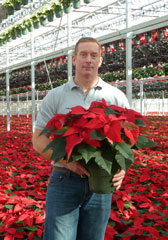 CK Greenhouses, Cheshire
CK Greenhouses, Cheshire Charlie Kurtz has become an expert at balancing many things, one of which is his customer base. Selling both to independents and big box stores, CK Greenhouses ensures it provides a variety of different products to fulfill every demand. “There’s a lot of competition [out there], so you have to find the right balance,” said Charlie.
This includes offering some different elements other than novelty colors, like painted and glittered poinsettias, and poinsettia trees. Charlie was one of the few growers in the area that still offer these. He also grows in the standard sizes from 4 in. to 10 in. Seventy percent of his crop is red—mostly Prestige and Premium. “I’ve found over the years that if you’re out of certain colors, the customers will always take red,” Charlie said. But he also grows Whitestar, Ruby Frost, White Christmas and Marble Star.
And although he doesn’t grow as much as he did when he opened 15 years ago, his volume has increased during the last few years because many of his competitors have stopped growing poinsettias, so he’s trying to capture some of that market. Charlie believes it’s a mix of the bad economy and the high-maintenance aspect that have forced some growers out of the poinsettia business.
It seems all of his extra efforts have paid off, because when we asked him to rate the overall season, Charlie said it
was a 7.
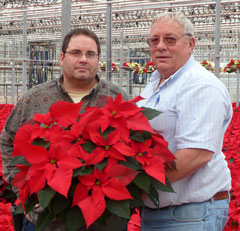 Kurtz Farms, Cheshire
Kurtz Farms, Cheshire A few minutes down the road, Charlie’s uncle and cousin were busy with their own poinsettia crop. Hugh Kurtz and his son Hughie also sell to IGCs and big boxes, but they deal with a larger volume—about 300,000 total poinsettias are grown in their greenhouses. Although the market is flat, Hughie said they’ve been growing about the same amount during the last couple of years because, as Charlie said, a lot of growers aren’t offering poinsettias anymore.
Hugh shrugged his shoulders and said, “I don’t know why people would drop it. If you don’t grow poinsettias, it could impact your spring business. Customers would just go somewhere else.”
One thing that has changed is the number of larger sizes they’re growing. The smaller 4-in. pots are still popular, said Hugh, but consumers are buying more 8 in. and 10 in. “The bigger stuff is increasing,” stated Hughie. “All the big stuff sells. Those who are saying that people aren’t buying … that’s a fallacy.” They also grow the mini 2-in. pots, which many of their customers use as impulse-purchase items. Prestige Red makes up most of the 75% total red varieties they offer, followed by white, pink and novelties.
In terms of the business as a whole, including spring and Christmas, Hughie said they’re not up, but they’re still making a small profit. “We’re building new greenhouses, so we’re doing alright,” he said.
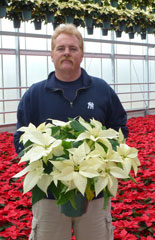 Cromwell Growers, Cromwell
Cromwell Growers, Cromwell Like many in the business, Ed Bartolotta has growing in his blood. When Cromwell Growers was strictly a rose producer many decades ago, Ed’s grandfather was the head grower. After his grandfather and father opened Bartolotta’s Greenhouse, Ed joined on as head grower. In 1991, Ed brought the Cromwell Growers and turned it into a wholesale bedding plant operation.
Cromwell Growers sells poinsettias from 4.5 in. to 10 in. to Home Depot, but also grows for IGCs and grocery stores. This season, Ed said production was ahead because of “perfect weather” during November, which not only allowed them to grow the best quality, but ensured that the plants were ready earlier. It’s a trend Ed has noticed during the last few years. “The season is starting and ending earlier,” he explained. “We’re not shipping on December 20 like we did 10 years ago.”
When asked how many poinsettias he grows, Ed was tightlipped, but he did say that 70% of them are red, mostly Prestige and Peterstar. He also grows whites, pinks and some novelties like Cortez Burgundy and Monet. “We do a little bit of everything,” said Ed, but “I don’t want to have a lot of novelties later in the season. By then it’s red, red, red.”
During the last three years, poinsettia sales have been flat, said Ed, which he believes is because of the economic downturn. But he did say that 2011 was up from the previous year. “We attribute this to mild weather, a higher-quality crop and a moderate increase in consumer demand,” said Ed. However, he was quick to point out that overall gross profits were low because of the production costs associated with poinsettias.
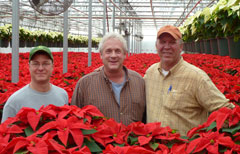 Geremia Greenhouses, Wallingford
Geremia Greenhouses, Wallingford Out of eight children, Joe Geremia was the lucky one to take over his father’s greenhouse business in 1989. Joe’s dad Salvatore still runs the small retail shop, but Joe, his business partner Phil Banning, and head grower Paul Barnes handle the 8-plus acres of total greenhouse production for their IGC customers.
More than 50,000 poinsettias are grown on Dutch rolling benches. Seventy-five percent of that is red varieties and the rest is made up of white and novelties, but they’re not picky. Paul says, “We basically grow whatever the customer asks us to. They do all of the selecting.” But the percentages have changed over the years, said Joe. Before, it was 70-20-10 (red-white-novelties), “now it’s more like 50-50 when they first start shipping. Closer to Christmas, it’s strictly red,” he explained.
Their sizes range from 4.5 in. to 10 in. and Joe says the smaller ones are the more popular with their customers. “It’s like a commodity business with the big numbers, but the money’s in the smaller stuff,” said Joe. They’re also growing more mid-sized—7 in. and 8 in.—than in previous years.
The season ended on a high note—especially since they sold out a week before Christmas—so Joe gave it an 8. From a growing standpoint, Paul said it was an “enjoyable season” because of the great weather and no problems during shipping. “It’s onto spring full steam ahead,” he said.
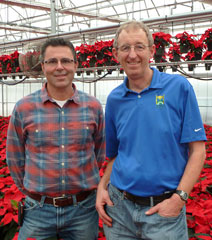 Michael’s Greenhouses, Cheshire
Michael’s Greenhouses, Cheshire Roger McGaughey knows about every poinsettia plant in his greenhouses. Like a doctor with his patients, he examines them from bracts to root, knowing which ones need special care and which are ready to be sent out. Luckily this year, Michael’s Greenhouses’ head grower (and
GrowerTalks columnist) experienced a good year with his poinsettias. Two years ago, Roger was faced with a nasty case of Xanthomonas that nearly wiped out his crop. This season had Roger smiling.
“I’m happy to report that RootShield and nematodes did the trick,” said Roger. “Yet another season without using chemical fungicides and no root problems existed. Shrink from plants collapsing with root issues is no longer a problem. Ulcers and sleepless nights are a thing of the past.”
Michael’s offers a wide variety of sizes to Home Depot, independents and grocery stores—from 4.5 in. to 8 in.—but they also grow 10-in., along with special 12-in. containers for local florists. Roger said about 80% of the 60,000 poinsettias are red, specifically Prestige and Premium. They also grow Peterstar White, Whitestar, Peterstar Marble and Maren (although a problem with whiteflies will have Roger switching from Maren to Peterstar Pink next season). This year, Roger and his team of young growers grew more 6 in., and less 6.5 in. and higher, than last year.
Despite the excellent year for growing, Roger and owner Michael Arisco gave the overall poinsettia season a 3. Not because sales were bad—far from it—but because of the high cost of fuel, which the business has struggled with during the last few years. Their high volume of church orders extends the need for heat right up until Christmas, so they use quite a bit of energy. Fortunately, Michael’s Greenhouses are currently working with the town of Cheshire to extend a natural gas line to the greenhouses, which should bring the cost of heating down significantly next year, said Roger.
“If you can survive in these times, when the economy turns around, we’ll be that much better,” said Michael. “We have a strong customer base, so we’re doing well and looking forward to spring.”
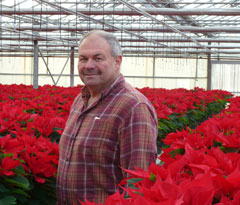 Vauiso Farms, Branford
Vauiso Farms, Branford Maneuvering past large trucks filled to the gills with Christmas trees and greenery, Joe Vauiso managed to take a break from dealing with impatient truck drivers to walk through his poinsettia greenhouse. His 26-year-old greenhouse now has brand new trough benches, concrete floors and new shade curtains that allowed for a really good crop this year, said Joe.
Along with the hundreds of Christmas greens from Canada, Vauiso Farms also grows about 12,000 poinsettias for independents, florists and local fundraisers. “A few years ago, we grew a lot of novelties,” said Joe. “This year, we’re back to basics again.” They still grow novelties like Da Vinci and Cortez Burgundy, but about 70% of Joe’s crop is Prestige Red. Most of those are grown in larger-size pots (8.5 in., 10 in. and 12 in.) because that’s what’s popular. One thing we noticed was that out of all the growers we visited, Vauiso Farms offers the most glittered poinsettias.
Joe agreed that the poinsettia market is flat, “but during the last two years, business has been better. Not because people are buying more—we picked up some market share from growers who don’t do them anymore.”
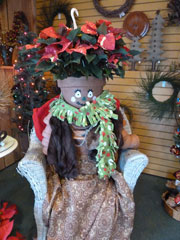 Smith’s Acres, Niantic
Smith’s Acres, Niantic The quaint seaside town of Niantic makes for a pretty backdrop for Smith’s Acres, Joe and Teri Smith’s 1-acre grower/retailer operation. Teri was elbow deep in Christmas greenery when we walked in, helping her staff prepare the plethora of custom-made wreaths for their customers.
Teri said they buy in all their trees and greenery (from Vauiso Farms, actually), but they grow all of their own poinsettias, mostly in the larger sizes because that’s what sells. “I’m amazed the bigger ones are selling,” Teri said. So, they grew more 8.5 in. and 10 in. this year, cutting down on 6.5 in. and 4.5 in. … and the small ones are what sold out first. Go figure!
Half of her crop is red varieties, with 15-20% whites. They grow some red and whites together in combos, which sell really well, said Teri. Another thing that surprised her was how early people were buying them. “Before Thanksgiving, we moved some of the bigger plants into the retail area to make more space in the greenhouse and people bought them!” Teri exclaimed.
One thing Teri and Joe struggle with is marketing to her spring and Christmas customers—because both groups are totally different. “How do you market Christmastime in the spring?” said Teri. “I could do coupons, but nobody holds onto them for that long.”
Smith’s Acres’ e-newsletters seem to help, and Teri and Joe also advertise on the local radio station. Plus, being on the corner of a very busy intersection, they’re in a prime location.
When asked how the season turned out, Teri said that they actually had to buy in poinsettias from other growers in order to fulfill their orders for schools and churches, so it was good season. “I think that with the warmer temperatures, it helped us make a few extra dollars on poinsettias this year,” said Teri.
 Woodland Gardens, Central Manchester
Woodland Gardens, Central Manchester Luke Zapadka, who runs Woodland Gardens with his father Leon and sister Bethany, was proud to say that they were having one of the best poinsettia crops compared to the last eight to 10 years. They grew with biocontrols and the weather was good, making the crop “the most uniform it’s been in a while,” said Luke.
Out of the 8,000-plus poinsettias they grow, Luke said 60% are red (Red Velvet, Prestige and Peterstar Red), but they also sell many novelties such as Marble, Maren, Glitter and Da Vinci in smaller sizes, like a 3-in. square pot. Luke said the reds sell better in the bigger containers. “The percentages haven’t really changed that much [over the years]. Maybe a few less pinks,” said Luke. “Next year, we plan on doing more larger sizes.”
Speaking of containers, Woodland Gardens offers a unique twist for poinsettias. They have a special pot with a “trench” around the inside where they plant Diamond Frost Euphorbia and then drop in a poinsettia to make an instant combo.
The season turned out to be an 8 out of 10 for the Zapadkas, as they were very happy with their poinsettia crop, said Luke—and so were their customers. “A long-term employee said he thinks it was the best [season] he’s seen,” said Luke.
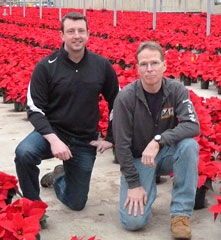 Grower Direct Farms, Somers
Grower Direct Farms, Somers We saved the largest wholesale grower in the area for last. Grower Direct Farms owned by Len Van Wingerden has more than 18 acres under cover and 20 acres of outdoor production. Sales director and Len’s son-in-law Ryan Horn gave us a tour of their facility, when much of their 400,000 poinsettias were being shipped to Home Depot, Walmart and Sam’s Club.
Ryan said that about 80% of their crop is made up of red varieties, like Viking, Prestige, Red Velvet, Euro Glory and Infinity. Head grower Mark Kelley said they only grow about 5% white because the other 15% are novelties. Glitter, Ice Punch, Marble and Viking Cinnamon are the most popular.
So, Grower Direct sells more novelties than many growers in the area—why? Ryan says he believes it’s because big boxes tend to sell more novelties than the independents. They also sell a lot of combinations with red and white varieties mixed. “We continue to try and come up with new ideas to get younger customers to buy them,” said Ryan.
They had a slight problem with a bacterial disease, but got it under control right away, said Mark. “Overall, it was a good crop,” he said. “The weather was good and everything finished pretty well.”
“I’m going to rate the season at a 6,” said Ryan. “Things got off to a slow start and stayed that way for a while. However, we saw greater sales in the week leading up to Christmas that enabled us to catch up. We did see a greater demand for white poinsettias this year, so we will be ratcheting up the percentage of white a bit for next year.” GT